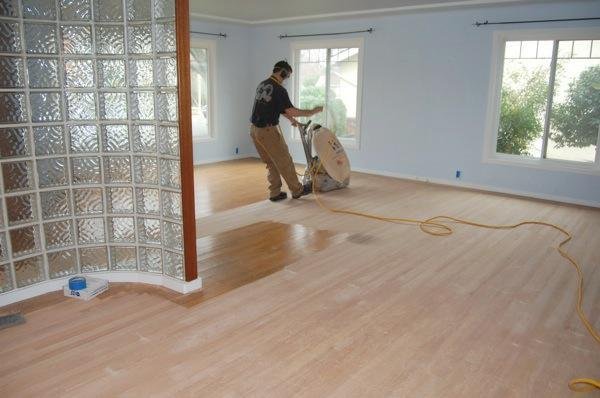Renew a wood floor in half the time and at half the expense of sanding. The secret is to screen the old finish. Read on to see if screening will work for your floor.
Sanding vs. screening
When a wood floor loses its luster, the usual solution is to sand it down to raw wood and completely refinish it. But often, that’s the wrong solution. Refinishing hardwood floors is the right solution.
All wood floors are protected by a clear coating that eventually becomes scratched, scuffed and dull. Refinishing hardwood floors can help you get rid of those unsightly scratches and marks. But as long as the damage is shallow—in the coating and not in the wood itself—you can renew the floor by adding a new coat of polyurethane right over the old finish.
This article will show you how to do just that. As with any wood-finishing project, 90 percent of this job is preparation. You have to thoroughly clean the floor, touch up any deep scratches and roughen the existing finish with sanding screens so the new finish will adhere well. Expect to spend at least one full day on this prep work. The recoating itself usually takes less than an hour.
Recoating takes a lot less time, skill and money than full-scale sanding and refinishing. And although roughing up the existing finish creates plenty of dust, it’s still much less messy than sanding down to bare wood. There’s another advantage: Every time you sand a floor down to bare wood, you remove some of the wood. A solid wood floor can be sanded several times before that’s a problem. But laminated floors (glue-down or floating floors) have only a thin layer of good-looking wood veneer over a plywood-like base. The veneer can be sanded once or twice—after that, sanding will expose the plywood core beneath.
Where recoating won’t work
The type of flooring you have doesn’t matter. Recoating works on solid wood, laminated wood and parquet floors alike. But a new coat of polyurethane may not stick to your existing finish.
If your floor’s finish was applied before the 1970s, it’s probably wax, old-fashioned varnish or shellac. No new finish will stick to a wax finish or any other finish that’s ever had wax applied to it. Polyurethane might adhere to an old, unwaxed varnish or shellac finish. But these finishes do wear out, and since they’re probably more than 30 years old, it’s best to sand them off and start over.
In fact, if you have an old finish from the days before polyurethane, your only alternative to sanding is wax. If the floor is in fair condition, wax can restore the shine. A wood flooring dealer can recommend a suitable product. Wax is easy to use, but not very durable. You’ll probably have to rewax every six months or so.
Even if the existing finish is polyurethane, good adhesion isn’t a sure thing. Residue from all kinds of household chemicals, such as furniture polish, glass cleaner, insecticide and wallpaper paste, can interfere with adhesion. Since you can’t know for certain all the potions that have landed on your floor, you must test for adhesion before you recoat your floor.
For more information call me. I’m here to help 305-776-3584

